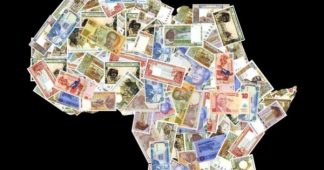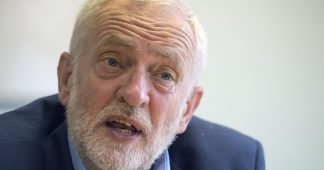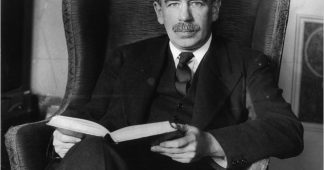By Adam Booth
“Practical men who believe themselves to be quite exempt from any intellectual influence, are usually the slaves of some defunct economist. Madmen in authority, who hear voices in the air, are distilling their frenzy from some academic scribbler of a few years back.”
– John Maynard Keynes
Modern Monetary Theory (MMT) is the latest craze to hit left-wing circles; the supposed panacea to the problems that a future Bernie Sanders administration or Jeremy Corbyn government will likely face.
Advocated by leading lights of the Democratic Party in the USA, such as Alexandria Ocasio-Cortez (AOC), and by those trying to gain the ear of Jeremy Corbyn and John McDonnell in the UK, MMT is currently the talk of the town on the left. And it’s not hard to see why. After all, the concept offers activists an easy rebuttal to right-wing critics who ask how radical policies will be paid for.
In this sense, MMT might as easily stand for ‘magic money tree’. That, after all, is what this theory promises: a way of funding everything we want, and more, without having to worry about the hassle of taxation or – more importantly – class struggle.
Think the left’s shopping list of demands are unaffordable? Think again! Want free healthcare and education? No problem, we’ll just print money. Mass investment in green energy? Don’t worry, we can turn on the government’s taps. Build a million council homes? Easy – we’ve got MMT.
But, truth be told, Modern Monetary Theory is a bit of a misnomer. In reality, it is not much of a theory. Nor is it particularly modern. As John Maynard Keynes once noted, those imagining themselves to be ‘pragmatic’ and ‘practical’ are all too often in fact the slaves of some defunct economist – in this case, none other than Keynes himself.
Consensus breaks
The fact that a broad debate has opened up around economic alternatives to austerity should come as no surprise to anybody. After a decade of crisis and cuts, workers and youth are rightly calling into question the neoliberal consensus that has continued to hold court, despite the seemingly never-ending ‘Great Recession’.
With growth stalling, business investment stagnant, and monetary policy at its limits, even mainstream capitalist economists (generally of a Keynesian variety) are now challenging the demand for balanced budgets. After all, with austerity failing and interest rates at 0%, what other weapons do governments have left in their arsenal?
For the bourgeois priesthood that defends this capitalist creed, however, any criticism of the all-powerful ‘invisible hand’ of the market is sacrosanct. Hence the barrage of attacks and insults that is thrown in the direction of any alternatives put forward.
“MMT is appropriate only in exceptional situations,” claimed John Llewellyn, a former chief economist of the OECD, “where economies are far from full employment, deflationary pressures are in evidence, and interest rates are at the zero bound”.
The problem for Llewellyn and his cohort, however, is that these “exceptional” conditions are the ‘new normal’. The situation he describes sounds very much like that which the world economy has faced for the past decade or more.
Larry Summers, an economic advisor to Barack Obama and former head of the US Treasury under Bill Clinton, has even described the global economy as being in a state of “secular stagnation”: one with permanently subdued demand and muted private investment, where “fairly ordinary growth” is sustained only by “extraordinary policy and financial conditions”.
This situation, Summers argues, has existed not just since the 2008 crash, but in the decades preceding it also. The world’s economic engine has only been kept going thanks to an endless injection of cheap credit and government stimulus. The ‘exception’, then, has become the rule.
Those criticising MMT from the right, therefore, clearly aren’t in a very strong position to do so. After all, as Paul Krugman, the Nobel Prize winning economist, admitted in a speech to an audience at the London School of Economics in the wake of the 2008 crash: “Most work in macroeconomics in the past 30 years has been useless at best and harmful at worst.”
Unfortunately for the MMTers, however, two wrongs do not make a right. And it is the duty of socialists to provide an honest appraisal of the ideas being proposed, in order to show the way forward for the labour movement.
What is MMT?
First off, it should be noted that MMT is a tricky beast to define. Indeed, this eclectic theory has almost as many versions as there are followers.
Of interest to us here, however, are those who put forward MMT from a supposedly left perspective. These include, amongst others: Stephanie Kelton, a senior economic adviser to Bernie Sanders; Bill Mitchell, a vocal MMT advocate who has managed to gain an audience with left-wing MPs in Britain; and Richard Murphy, a prominent tax campaigner and political economist in the UK.
In order to deflect criticism, MMT’s devoted army of followers attempt to bamboozle their opponents with a series of contortions and mental gymnastics. Traditional economic ideas are turned inside out and upside down, confusing the viewer like the optical illusions of an Escher painting. As the Economist journal wryly noted:
“Speaking with MMT’s adherents is sometimes like watching a football match with friends who insist the ball remains stationary while every other element in the game, including the pitch and goalposts, moves around it.”
In fact, even MMT’s own supporters state that it is less a theory, and more a “description of how the monetary system works”; an analytical “lens” that can help us to see the existing economic reality.
Putting aside the fact that a theory, in a scientific sense, is precisely an analytical explanation of reality, what is it then that MMT has to offer? What supposedly radical new perspective does this “massive paradigm shift” provide?
Most fundamentally, MMT asserts that:
- A government that issues its own sovereign, ‘independent’ currency can never run out of money, since it can always choose to pay for any debts by creating more money.
- Inflation will not kick in if such a government spends lavishly and runs a budget deficit, as long as there is spare productive capacity in the economy.
- Taxes do not fund public spending. Governments, therefore, do not need to tax first in order to spend later. Indeed, the real process at play (we are told) is the opposite – governments spend on goods and services, and then adjust tax rates in order to manage demand in the economy.
Although this ‘description’ of the economy doesn’t explicitly lead to any policy conclusions, MMT has unsurprisingly been leapt upon by some left-wingers for what it necessarily implies: that governments need not worry about balancing the books, and can always find the money to foot any bills.
Indeed, this has been spelt out by leading MMT proponents. For example, when rhetorically asking her followers on Twitter “Can we afford a Green New Deal?”, Stephanie Kelton replies: “Yes. The federal government can afford to buy whatever is for sale in its own currency.”
Q: Can we afford a #GreenNewDeal?
A: Yes. The federal government can afford to buy whatever is for sale in its own currency.— Stephanie Kelton (@StephanieKelton) February 7, 2019
Elsewhere, Richard Murphy, has stated that: “What this [MMT] means is that there is no requirement per se to balance the government’s books. Indeed it is not just illogical but completely economically perverse to seek to do.”
Despite being the self-proclaimed author of ‘Corbynomics’ and founder of demands such as ‘People’s Quantitative Easing’ and the UK’s version of the Green New Deal, Murphy has been kept at arm’s length by the Labour leadership, who have categorically rejected MMT and its policy prescriptions.
What is money?
At root, the problems with MMT lie with its (mis)understanding of what money is, and what role money plays under capitalism.
MMTers subscribe to a theory of money known as ‘chartalism’. This term was coined (no pun intended) by a German economist called Georg Friedrich Knapp, who put forward a hypothesis called ‘the state theory of money’.
In short, Knapp asserted that money originates with the state and its imposition of taxes upon a people. The state, according to chartalists, creates money – and then creates a demand for this particular currency by insisting on its use as a ‘means of payment’.
To truly understand the nature of money, however, we must turn to another 19th century German economist: Karl Marx.
In Capital, Marx noted that “the riddle presented by money is but the riddle presented by commodities”. In other words, to understand the role of money in society, we must first understand its real origins – those of commodity production and exchange.
Marx explained that money’s history is tied to the rise of the commodity: goods and services produced not for individual consumption, but for exchange. All commodities, Marx showed, have an exchange value. This is a relationship – a ratio – between commodities, expressing how much of one product would (on average) be exchanged for another.
Building on the ideas of his predecessors, such as David Ricardo, Marx outlined how the value of a commodity is dependent on the labour embodied within it. This labour consists both of the ‘dead labour’ contained within the raw materials, tools, etc. required for its production, and the ‘living labour’ labour added in the production process by the worker.
Marx called this total labour the ‘socially necessary labour time’: the time required for the production of a given commodity, based on the current level of technology and industry, etc. within society.
With this in mind, Marx explained in his Contribution to the Critique of Political Economy how money serves several functions:
- As a unit of account, or measure of value. In money terms, this is represented by prices.
- As a medium of exchange. In this role, money breaks up the circulation of commodities into two separate acts: an act of sale (C-M, a commodity exchanged for money); and an act of purchase (M-C, money exchanged for a different commodity).
- As a store of value, allowing accumulated wealth to be maintained and preserved over time.
- And as a means of payment, allowing debts (denominated in a certain currency) to be settled and taxes to be paid.
Money, therefore, plays a number of roles. Above all though, money is a representation of value: the ultimate expression of the generalisation of the law of value; the logical conclusion of the development of commodity production and exchange, which requires a universal yardstick – a standard measure – against which the value of all other commodities can be expressed.
And yet chartalism (and also MMT) offers no analysis of value, or of commodity production and exchange. As a result, it misses the essence of capitalism, and of money’s role within it.
Money arises historically, not by design, but as a result of the development of commodity production and exchange. It begins primarily as a ‘money commodity’, such as the precious metals, with a value of its own, but later develops to be a mere symbol of value. This is clear today, where money is predominantly not coins, but cash and credit; notes and numbers.
Importantly, in this respect, Marx emphasised that we must understand money as a social relation. Money itself is not wealth, but is a claim to a portion of the total social wealth created in production – ultimately by the labour of the working class.
Money and the state
The chartalists and MMTers, then, are correct to say that the state can create money. But the state cannot guarantee that this money has any value. Without a productive economy behind it, money is meaningless.
Money is only a representation of value. And real value is created in production, as a result of the application of socially necessary labour time. The money that a state creates, therefore, will only be of any worth in so far as it reflects the value that is in circulation in the economy, in the form of the production and exchange of commodities.
As Marx noted, the sum of the values in circulation must ultimately equal the sum of the prices of these commodities. Where this is not the case, then this is a recipe for inflation and instability.
The state can of course choose what unit of measurement to use when accounting for the value in its economy, just as Americans choose to measure distances in feet, whilst Europeans choose metres. But whether we choose feet or metres, this does not alter the objectives heights of objects in the real world. Nor does constructing more rulers and tape measures.
Similarly, a society does not get wealthier by imagining itself to be so, by printing money or otherwise. As David Graeber explains in his book Debt: the first 5,000 years, referring to the arguments of 17th century English philosopher John Locke and his theories on money:
“Locke insisted that one can no more make a small piece of silver by relabelling it a ‘shilling’ than one can make a short man taller by declaring there are now 15 inches in a foot.”
In any case, Knapp and his MMT followers are wrong to say that the state creates the demand for money. Under capitalism, as the Positive Money campaign have highlighted, the vast bulk of money in circulation – 97% of all money in the economy – is not created by governments but by private banks, in the form of bank deposits.
This money is created in response to demands from consumers and investors, as credit and loans. Where this demand dries up, in terms of falling household consumption and/or business investment, so too does the demand for money.
So the state can create money. But it cannot ensure that this money is put to use. Indeed, the vast programmes of Quantitative Easing that have been conducted across the advanced capitalist world since the 2008 crash are a testament to this.
Trillions have been pumped into the economy by central banks over the past decade, and to what effect? Business investment and GDP growth remain subdued. And yet asset prices – on the stock market and of property, gold, cryptocurrencies, and even artwork and fine wines – froth and fizz like a newly opened bottle of champagne. In short, the speculators are having a field day, whilst ordinary people struggle to make ends meet.
In summary, it is not the state that creates the demand for money, but the needs of capitalist production. And this production is ultimately driven by profit. Businesses invest, produce, and sell in order to make a profit. Where the capitalists cannot make a profit, they will not produce. It is as simple as that.
And yet chartalism – and thus MMT also – has nothing to say about profit, the motor force of the capitalist system. As a result, it cannot explain the real dynamics of the economy under capitalism.
Read more at http://www.socialist.net/marxism-vs-modern-monetary-theory.htm











